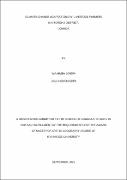| dc.description.abstract | The study “Climate Change Adaptations by Livestock Farmers in Ntoroko District” analyzed the extent of climate variability and examined the factors that influence farmers’ choice of specific adaptations to Climate Change in Ntoroko District. The study’s specific objectives were to determine trends in climate variability in Ntoroko District, to determine the climate change adaptations used by livestock farmers in Ntoroko District, and to investigate the factors influencing livestock farmers’ choice of adaptations to climate change in Ntoroko District. A cross-sectional survey research design was employed where qualitative and quantitative methods were used. 351 respondents from a population of 4011 were sampled using a simple random sampling technique. The study used a questionnaire, documentary review, and observation to collect data on the variables of the study. Data collected was analyzed using Linear Regression, Cross-tabulation, and Multivariate in terms of tables and graphs respectively. The findings on climate shown that the mean annual rainfall amounts for Ntoroko District decreased for the period 1988 to 2018, varying from 95.8mm to 43.8mm. This decrease was statistically insignificant indicating that the area was no evidence of climate change in annual rainfall pattern for the period of study. In addition, analysis of mean annual maximum temperature for the study area for the period 1990 to 2018 showed a positive/increasing trend that was statistically significant. The results further revealed that most dominant adaptation practices to climate change used by livestock farmers in Ntoroko were stocking of animal drugs supported by (95.5%) herd mobility (67.6%) and mixed animal rearing (66.8%). Additionally, the Multivariate Regression Model revealed that access to training on climate change followed by monthly income, access to information, and membership to the social group were the most significant factors that positively influenced farmers' choice of adaptations to climate change while the least significant factor was education status of the household head. The study recommended that farmers should be provided with meteorological information on rainfall and temperature trends that may aid in the planning of adaptations to a varying climate. The existing adaptation practices such as stocking animal drugs and mixed animal rearing should be supported and encouraged with the aim of increasing livestock farmers’ resilience to climate variability and change. Finally, there should be improved access to training on adaptation, monthly income, and membership to a social group. This would therefore reduce climate change hazards and be a means to support livestock farmers’ adaptions to climate change in Ntoroko District. | en_US |

